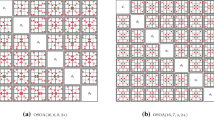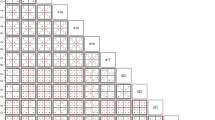Abstract
Constructions and nonexistence conditions for multi-dimensional Golay complementary array pairs are reviewed. A construction for a d-dimensional Golay array pair from a (d + 1)-dimensional Golay array pair is given. This is used to explain and expand previously known constructive and nonexistence results in the binary case.
Similar content being viewed by others
References
Borwein PB and Ferguson RA (2003). A complete description of Golay pairs for lengths up to 100. Math Comput 73: 967–985
Budis˘in SZ (1990). New complementary pairs of sequences. Electron Lett 26: 881–883
Craigen R, Georgiou S, Gibson W and Koukouvinos C (2006). Further explorations into ternary complementary pairs. J Combin Theory (Series A) 113: 952–965
Craigen R, Holzmann W and Kharaghani H (2002). Complex Golay sequences: structure and applications. Discrete Math 252: 73–89
Craigen R and Koukouvinos C (2001). A theory of ternary complementary pairs. J Combin Theory (Series A) 96: 358–375
Davis JA and Jedwab J (1999). Peak-to-mean power control in OFDM, Golay complementary sequences and Reed-Muller codes. IEEE Trans Inform Theory 45: 2397–2417
Davis JA, Jedwab J and Smith KW (2007). Proof of the Barker array conjecture. Proc Amer Math Soc 135: 2011–2018
Dymond M (1992) Barker arrays: existence, generalization and alternatives. PhD Thesis, University of London
Eliahou S, Kervaire M and Saffari B (1990). A new restriction on the lengths of Golay complementary sequences. J Combin Theory (A) 55: 49–59
Eliahou S, Kervaire M and Saffari B (1991). On Golay polynomial pairs. Adv App Math 12: 235–292
Fiedler F, Jedwab J, Parker MG (2006) A framework for the construction of Golay sequences. IEEE Trans Inform Theory (Submitted)
Fiedler F, Jedwab J, Parker MG (2006) A multi-dimensional approach to the construction and enumeration of Golay complementary sequences. J Combin Theory (A) (Submitted)
Gavish A and Lempel A (1994). On ternary complementary sequences. IEEE Trans Inform Theory 40: 522–526
Golay MJE (1949). Multislit spectroscopy. J Opt Soc Amer 39: 437–444
Golay MJE (1951). Static multislit spectrometry and its application to the panoramic display of infrared spectra. J Opt Soc Amer 41: 468–472
Golay MJE (1961). Complementary series. IRE Trans Inform Theory IT-7: 82–87
Golay MJE (1962) Note on “Complementary series”. Proc IRE 50:84
Jedwab J (2005) A survey of the merit factor problem for binary sequences. In: Helleseth T et al. (eds) Sequences and their applications—Proceedings of SETA 2004, vol 3486 of Lecture Notes in Computer Science, Springer-Verlag, Berlin Heidelberg, pp 30–55
Jedwab J, Parker MG (2007) There are no Barker arrays having more than two dimensions. Designs, Codes Cryptogr 43:79–84
Jedwab J and Yoshida K (2006). The peak sidelobe level of families of binary sequences. IEEE Trans Inform Theory 52: 2247–2254
Lüke HD (1985). Sets of one and higher dimensional Welti codes and complementary codes. IEEE Trans Aerospace Electron Syst AES-21: 170–179
Ohyama N, Honda T and Tsujiuchi J (1978). An advanced coded imaging without side lobes. Optics Comm 27: 339–344
Paterson KG (2000). Generalized Reed-Muller codes and power control in OFDM modulation. IEEE Trans Inform Theory 46: 104–120
Shapiro HS (1951) Extremal problems for polynomials and power series. Master’s thesis, Mass Inst of Technology
Turyn R and Storer J (1961). On binary sequences. Proc Amer Math Soc 12: 394–399
Turyn RJ (1963) On Barker codes of even length. Proc IEEE 51:1256
Turyn RJ (1968). Sequences with small correlation. In: Mann, HB (eds) Error correcting codes, pp 195–228. Wiley, New York
Turyn RJ (1974). Hadamard matrices, Baumert-Hall units, four-symbol sequences, pulse compression and surface wave encodings. J Combin Theory (A) 16: 313–333
Author information
Authors and Affiliations
Corresponding author
Rights and permissions
About this article
Cite this article
Jedwab, J., Parker, M.G. Golay complementary array pairs. Des. Codes Cryptogr. 44, 209–216 (2007). https://doi.org/10.1007/s10623-007-9088-z
Received:
Revised:
Accepted:
Published:
Issue Date:
DOI: https://doi.org/10.1007/s10623-007-9088-z




